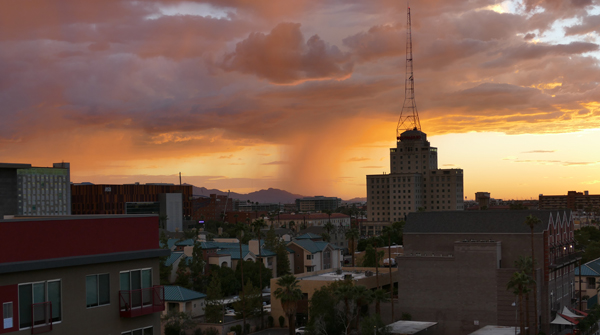Located in one of the most arid regions of the United States, the city of Phoenix struggles with reducing its environmental footprint.
The Sierra Club’s 2016 Environmental Report Card, which grades Arizona’s governor and all its legislators based on their efforts to promote environmental change, showcased Arizona’s lack of change, citing the legislature at the helm.
“The Arizona Legislature is determined to allow harm to what makes Arizona special,” said Sandy Bahr, director for Sierra Club’s Arizona chapter. “Rather than taking advantage of our 300-plus days of sunshine and growing solar industry and the jobs it provides, legislators passed a bill to hinder installations and even considered proposed constitutional amendments that would have likely destroyed the rooftop solar industry in Arizona.”
Phoenix is no stranger to environmental issues. Despite a minor improvement in the Sierra Club’s report card – Gov. Doug Ducey received a D in 2015 compared to a D+ in 2016 – problems with water, air quality, recycling, renewable energy and a warming climate continue to plague Phoenix.
Mark Hartman, the chief sustainability officer for the city of Phoenix, has been working toward a more sustainable city and acknowledges the difficulties faced in doing so.
“The sustainability issues (of Arizona) that are really most prevalent are here downtown, Hartman said. “It’s around the energy use of buildings. All of the buildings use far more energy than they need to, and the source is not environmentally clean.”
At a rate of about 8,100 kilowatt-hours per month, Arizona’s commercial electricity consumption ranks fifth highest in the nation, nearly 30 percent greater than the national average of 6,238 kwh per month. With high rates come high bills; Arizona’s average monthly commercial electricity bill totals $772, which ranks seventh in the nation.
Hartman said the best way to cut company costs is to look to sustainable efforts.
“There’s a huge cost-savings potential, it would cost less if we lived fully sustainably,” Hartman said. “Companies who are not thinking sustainably are realizing the disinvestment in their stocks.”
Companies in downtown Phoenix are a huge contributor to the city’s environmental footprint. The commercial electricity rate in Phoenix is 7.24 percent greater than the average of Arizona.
Hartman said the trend toward more sustainability starts with the downtown businesses and awareness.
“It’s a conversation that’s starting to happen,” Hartman said. “I think that the only way to be a truly sustainable city is a partnership between the businesses and the city, we really could not achieve our goals without partnership of downtown businesses.”
The notion of downtown businesses making the switch to more sustainable models seems long overdue. Cities like Portland, Seattle and San Francisco have already made the switch and have felt the positive effects.
The Sacramento Area Council of Governments conducted a 2005 study showcasing the economic benefits of building a sustainable city. The Council reported $9.4 billion less in public infrastructure costs, 14 percent fewer carbon dioxide emissions, $655 million less for residents’ annual fuel costs, and $8.4 billion less for land purchases to mitigate the environmental harm of development.
And surveys show that Arizona residents want a more sustainable environment. A study conducted by the University of Arizona and Stanford University in 2014 concluded that over 70 percent of Arizonians believe that Arizona’s governments should take action on global warming and should limit the amount of greenhouse gases emitted by businesses.
The primary reason for the lack of change lies in the legislature, Hartman said.
“There’s a significant misalignment between the 70 percent of people in Arizona who think it’s an issue that wouldn’t be represented at the legislature, and a lot of it is party related,” Hartman said.
Without progression from Arizona’s legislature, businesses downtown can’t capitalize on sustainable models. The Sierra Club’s report card is a key indication of the legislature’s failures on environmental issues.
The emergence of Arizona State University as a sustainable partner downtown has shown light in reducing Phoenix’s environmental footprint. The Sierra club recently named ASU the sixth most sustainable university in the country.
JoEllen Alberhasky is the program coordinator of sustainability at the downtown campus, and she said the sustainability effort downtown isn’t an easy one, especially with the Arizona legislature.
According to the Arizona Republic, the 40-year-old State Energy Program was shut down in 2015 due to Ducey and his administration’s deconstruction of the energy savings and efficiency program shortly after Ducey took office.
Alberhasky said the Legislature’s actions stifle progress.
“We’ve lost momentum,” Alberhasky said. “Events like the closing of the office of energy haven’t helped our efforts.”




